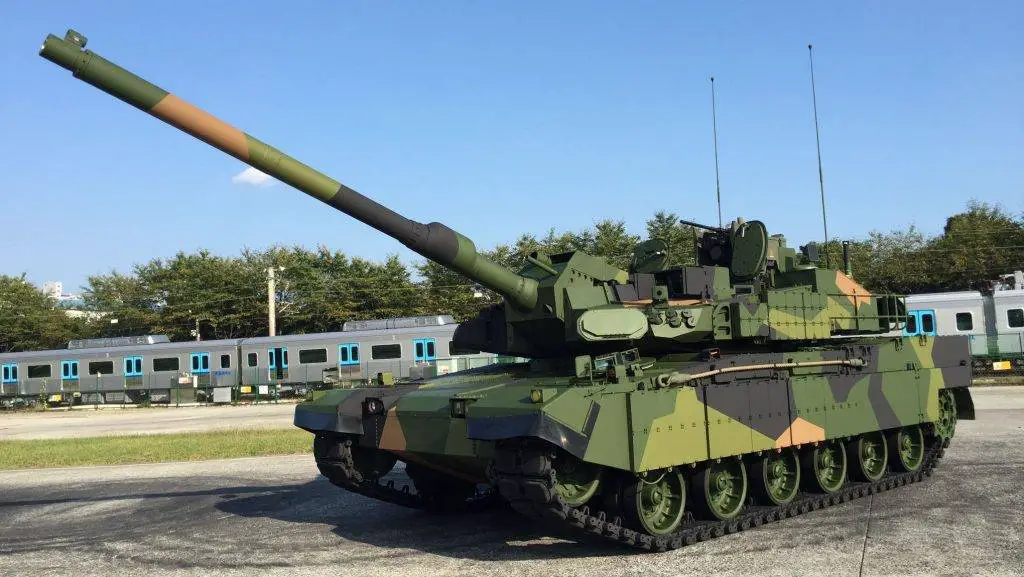Korean K2 Black Panther MBT is participating in the Norwegian battle tank evaluation. For K2NO, the Koreans have installed the Israeli Trophy Active protection system. South Korea has developed the Korean Active Protection System (KAPS) to equip the K2’s with the Korean Army. The question is, why is South Korea not offering KAPS to the Netherlands?
KAPS
In March 2012, the South Korean Defense Development Agency said it had created an active protection system for armoured vehicles.
KAPS is a complex system that includes a three-coordinate radar station, infrared sensors, a computer system and an anti-missile launcher.
The primary purpose is to detect incoming projectiles and guided anti-tank missiles at a distance of approximately 150 meters. After acquiring the enemy projectile, KAPS launches an interceptor missile that explodes at 7 to 22 meters from the target and knocks the incoming off course.
The active protection system (APS) takes about 0.2 – 0.3 seconds to launch once the incoming is detected. The armament of the APS includes 70-millimeter anti-missiles, which travels at a speed of 2.3 thousand kilometres per hour or about two Machs.
As per estimates, one KAPS kit costs about $ 840 thousand (in 2014) or close to a million dollars by now.
Since 2006, South Korea has spent about $36 million on KAPS development. The active protection complex was tested on the K-2 tank by multiple shelling from RPG-7 and Russian ATGM “Metis-M”.
KAPS was planned to be used on the K2 PIP modification, which would use the millimetre-wave radars already on the tank. The millimetre-wave radar installed on the K2 Black Panther tank operates as an integral part of the MAWS (Missile Approach Warning System) jamming system.
Israeli Trophy System
The U.S. and the European Tanks use Trophy Hardkill APS from Israel. The U.S. Army had hastily introduced the Israeli Trophy Hard Kill Active Defense System, which has proven its ability to intercept 9M133 Kornet anti-tank missiles in actual combat, in June 2017. The Trophy Active Defense System uses 360-degree radar to detect anti-tank missiles and rockets’ approach and then fires multi-explosive formed projectile (MEFP) interceptors to intercept them. The Israeli military has announced that the Trophy APS has been installed on the Merkava Mk 4 tanks and the Namer armoured personnel carrier based on a Merkava Mark IV tank chassis. Since its installation, not a single anti-tank weapon has pierced the combat vehicles.
Why was KAPS not installed on K2NO?
Korea does offer KAPS for exports, but since the Koreans do not use it on their K2 yet, the choice for K2NO fell on APS Iron Fist or Trophy – both systems Israeli systems, as they have been tested in combat conditions.
KAPS is not accepted abroad because it is prone to friendly fire. An official from Hyundai Rotem is on record saying that the KAPS model developed by the National Research Institute was made exclusively for largescale all-out use. Therefore, it is a model that cannot meet the current tank export market, which is sensitive to human casualties.

Another reason is that the KAPS APS radar cannot detect incoming if the tank operates jammers. In particular, it was found that when a smoke grenade is used during manoeuvring, the radar of KAPS could not detect the enemy’s anti-tank missile or RPG rocket, making it impossible to use the two systems together.
In tanks, the guided disturbance system and the counter-destruction system are considered to be the key defense equipment for surviving on the battlefield. A guided jamming system is a device that fires smoke grenades to prevent the enemy from measuring the distance with a laser which helps to fire an anti-tank missile or an RPG rocket. The counter-destruction system detects launched anti-tank missiles or RPG rockets, intercepts them at close range, and destroys them.
The cost of the Korean KAPS and Israeli Trophy system is roughly the same, about $1 million.
KAPS future
KAPS may not equip the K2’s of the Korean Army too. As per Korean MoD, KAPS was not originally intended for K2 tanks, and hence it does not work effectively with the tanks jamming systems. Even the K2 is criticised as a ‘luxury’ tank in South Korea due to its cost. South Korea has failed to build critical systems like the engine, the transmission and APS for K2.
